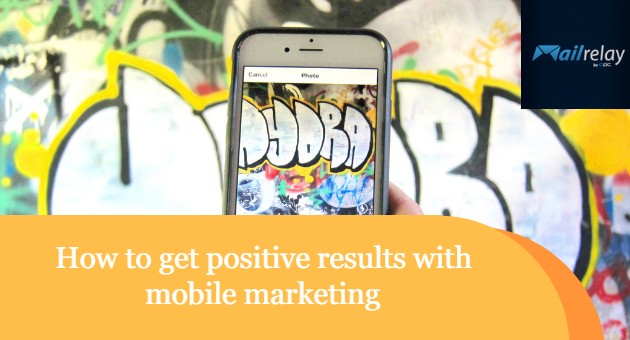
Mobile marketing is gaining ground in the world of digital advertising, and this is mainly due to the increase in the number of smartphones worldwide.
In Spain, the Comisión Nacional de los Mercados y la Competencia (CNMC) reported that at the beginning of the year, there were 53.4 million mobile phone lines in Spain.
This figure shows that there are more devices than people: there are about 46 million inhabitants in this country, so we have 1.16 cell phones per person. Crazy, isn’t it?
Reality confirms that the smartphone is here to stay. An inseparable companion in everyday life, these gadgets are often more important than our house keys, wallet, or identity card.
In fact, it is constantly used to satisfy a wide variety of needs. We use the smartphone to check the weather forecast, compare prices, check data, read emails, take pictures or record videos, for shopping, or share contente on social media. In other words, we have the world in the palm of our hands with a smartphone.
App Annie published in the ‘State of Mobile 2019’ data such as 194 billion of app downloads and an average of 3 hours of daily use.
The new digitalization of the environment has changed the two-way relationships between users and devices.
In this context, where things and people are connected, email plays a vital role as a communication tool.
To help you understand the advantages of mobile and email marketing, we will talk a bit about strategies.
The most critical elements of mobile marketing
Mobile email marketing involves two elements: advertising for mobile devices and email.
This commercial initiative basically consists in sending personalized messages to a segmented database.
The idea is to write a personalized message that will be sent to subscribers to create engagement with the recipients. This message will typically include a call to action to advertise the link the sender wants to promote.
At first glance, it seems a bit complex, and you may wonder, how do I get my customers to respond the way I want them to? When buying a product, purchasing a service, reading an article, entering a sweepstake, or signing up for a weekly newsletter. In the following paragraphs, we will examine this process’s main elements.
Actually, there is nothing special about it: It works the same way as other email marketing campaigns based on contacts, content, sending, and monitoring.
In fact, the main differences between email marketing for mobile devices and traditional email marketing are the tools for adapting the message to the device, the loading speed, and the personalization of the newsletters. We will see a little more in the following lines.
The message type will have to be changed to catch the user’s attention even more quickly since the user will have a lot of information at their disposal. If you can’t involve them very quickly, they will click on the following notification on the screen, and your message will be lost.
In fact, if the design and content have not been adequately optimized for mobile devices, it is likely that you will not succeed with this type of strategy.
Therefore, to make the process work as smoothly as possible, each element depends on the next and so on. If the subscriber does not like the layout of the email, they will probably close the the message in less than three seconds before even reading the newsletter’s content.
– Single column design for quick diagonal reading (at Mailrelay, we have templates specifically designed for this purpose)
– Easy-to-read, clean emails with concise messages and elements strategically placed, so they are easy to find
– Optimal layout in scalable media that can be adapted to different screen sizes
– Short, few-character subject lines and titles, including call-to-action bottons
– Attractive and original text, with symbols and icons
– The advertising campaign should be supported by an appropriate (also optimized) landing page that reinforces the promotion.

Pros and cons of mobile marketing
After seeing the vital elements for creating a successful mobile marketing campaign, it is time to explain some of its main advantages and disadvantages. Some of the benefits are:
– The proximity of the device to the user and its regular use in daily life gives rise to new relationships between brand and consumer; moreover, this direct contact helps improve brand awareness.
– Commercial messages are delivered directly to the user’s email inbox – if the user has given their consent beforehand – avoiding the feeling of intrusion. (Remember that unwanted emails are considered as spam).
– The hyper-connected user, 24 hours a day, 7 days a week, uses their smartphone to solve daily problems of all kinds and establishes closer or more direct relationships with the brands that, in turn, will gain in visibility and engagement.
– If you decide to work with mobile marketing and email marketing, you can measure the results of each action in real-time to track the evolution of your strategy, as well as to detect errors that could affect your campaign.
– It is much easier to track the newsletter, as it shows real-time results with details about the model or device, the geographic location, user activity, as well as other reports on user interaction.
– Contact through mobile devices facilitates the interaction between the brand and the user and its segmentation through strategies previously defined and analyzed by the sender.
– The results can be multiplied – users can share the content with their friends
– The ROI (Return on Investment) of these campaigns is more interesting since it is a cheaper system and with many segmentation options.
On the other hand, you should consider the following negative aspects before working with mobile marketing:
– Its dynamism and immediacy imply difficulty in capturing the attention of the user, a saturated and difficult to seduce consumer that is constantly being bombarded by notifications and messages from other applications.
– It is not always possible to identify the location of all users since some applications block this type of information, and each subscriber needs to give their consent for the application to share the location with the administrator
– Messages will end up in the spam folder if you don’t segment your email beforehand and don’t direct the newsletters to the right people; if you don’t create a subscriber acquisition and segmentation strategy; you can have very negative results.
– Problems can also arise in case of poorly designed messages or incorrectly generated contact lists.

Statistics for mobile marketing campaigns
The “Estudio Anual de Mobile & Connected Devices” published by IAB Spain quantifies the behavior of users of mobile devices in Spain in a sample of 7,620 people over 18 years old.
The analysis established the following mobile advertising trends.
The first refers to a responsive website, mobile display, and social media, followed by apps, mobile video, geolocation, and mobile SEM.
On the other hand, the advertising industry is not working as much with SMS, Whatsapp, ASO, and AR/VR mobile.
In addition to this trend analysis, the statistics provide interesting data such as the following:
– In Spain, the percentage of smartphone use as an Internet access device has increased from 18% in 2010 to 96% in 2019. (Source: Statista )
– Spain is one of the countries with the highest number of mobile lines per capita (we talked at the beginning of the post about 1.16 per person) and is also a world reference in fiber optic deployment. The National Commission of Markets and Competition ( CNMC )
identified 627,499 mobile lines in July, which is 4.5% more than the same month in 2018. In addition, reports indicate over 114.9 lines per 100 inhabitants, 1 point more than the previous year.
– Statista has identified some interesting figures, with a total of 47.96 percent of the world’s mobile Internet traffic and disparate percentages depending on the continent: Asia tops the list with 60.08%, followed by Africa with 54.08 percent and Europe with 38.60 percent.
Next is North America with 38.21%, followed by Oceania 37.42% and South America 31.31%.
– Email is opened more on mobile devices than on desktops, although this largely depends on the age of the subscriber, the type of industry or the design of the email.
Interaction rates in mobile marketing campaigns are significantly higher among younger generations than older people, especially if the target audience is under 34. (Source: Emailmonday )
– 37% of retail sales are completed by consumers via a mobile device. This confirms that you cannot sell without focusing on mobile marketing. (Source: Deloitte )
– Mobile users check their email three times more, and 70% check email through apps mainly in the morning. (Source: Google )
– 52% of customers are less likely to engage with a company if they had a bad experience via their mobile device. (Source: Wow Marketing Local )
– Approximately 9 out of 10 companies are developing a strategy to optimize their email marketing campaigns. (Source: Smart Insights )
– The November 2019 Digital Advertising Watch identified that 18% of advertising campaigns (programmatic or otherwise) are sent only to mobile and 57% to all devices (both smartphones and all other devices). Therefore, 75% of companies plan global campaigns that integrate all media, while only 25% of companies create campaigns exclusively for desktops. (Source: Iab Spain)

Creating a mobile marketing campaign with Mailrelay
We have prepared a tutorial for you to learn how to create a newsletter in five minutes using Mailrelay’s ‘Drag and Drop editor. When accessing the editor from the ‘Menu,’ click Newsletters -> Add and add a “title” with the “subject” of your message.
You can also preview the text to see how it will be displayed. And finally, choose the sender and group you will send your advertising message to.
After choosing the design you will use, we recommend adding your company logo and main image at the beginning. Don’t forget to add your website link as a URL so that when your contact clicks on the image, they will be directed to the blog/website.
Once you have set up this first visual aspect – with the subject line, the logo, and the image – you should focus on the description. Stop and think for a few minutes about the contente you want to send, and write an attractive text with phrases such as “Save money,” “Save time,” “Check our exclusive product,” “Don’t miss out,” “Last chance”, “Exclusive discounts,” ‘Today only,’ etc. This trigger is is fundamental to capture the user’s attention and arouse their interest, so they will continue reading the following lines.
When you are writing the content, think about the personality and interests of the reader, as that will allow you to adapt the writingstyle and define the aesthetic structure of the elements that you will use. Analyze how the information is processed by the recipient and the retina-brain relationship. With this in mind, edit your messages with a focus on aesthetics, taking care in colors, fonts and using eye-catching backgrounds or headings. Finally, don’t forget to add buttons like “read the article here.” “more information” to direct readers to relevant points of your message.
Finally, click the ‘Save’ option and send a test email. This way, you can see how your message will be displayed in the inbox, and you can make any changes to the campaign before you proceed with sending it to all your subscribers. With all this organized, you are ready to send your emails. Remember once again that it is essential that you filter and segment your users to adapt the messages to each profile. This indeed takes time, but in the end, it translates into better results, don’t forget that.

Conclusions
Email marketing focused on mobile marketing is an advertising strategy that more and more marketers worldwide are using. The number of smartphones is constantly increasing, and this type of device is transforming digital marketing strategies, as it offers many advantages for brands of all sizes, as they can reach a larger number of customers and establish closer relationships with them. Its use has also led to the birth of new marketing opportunities.
Its use has also led to the birth of new business opportunities for entrepreneurs.
Although it is difficult to capture the attention of a user who is increasingly stimulated and saturated with information from different devices at once, it is necessary to understand mobile technology as an opportunity and not as a barrier. For this reason, more and more global advertising strategies that integrate the use of mobile devices are becoming popular among marketers and entrepreneurs. Therefore, we should not ignore the fact that we communicate with a user who lives and interacts with the world through their smartphone screen. Finally, and if you have not done so yet, try to work with this strategy in your campaigns, and you will be surprised by the statistics.
Translated by Micheli.